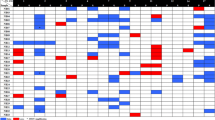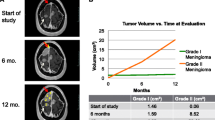Abstract
Meningioangiomatosis (MA) is a rare lesion appearing sporadically or as a part of neurofibromatosis 2. The occurrences of meningiomas arising from MA (MA-M) have raised doubts about the traditional concept of a hamartomatous origin for MA. Cytogenetic or molecular studies on MA, with or without meningiomas, are limited because of the rarity of MA. The current study was to evaluate the loss of heterozygosity (LOH) in seven cases of MA-M and two cases of pure MA. LOH on six chromosomes (1p32, 9p21, 13q14, 16q22, 17p, and 22q12) were investigated using 13 sets of microsatellite markers, including D1S193, D1S463, D22S193, D22S929, D22S282, TP53, D17S796, D16S421, D16S512, D13S118, D13S153, D9S162, and D9S104. PCR was performed using each marker and polymorphic analysis was accomplished by silver staining. Immunohistochemical stain for Ki-67 was carried out and labeling index was measured by using a semiquantitative manual counting method. The meningioma portions of MA-Ms showed LOH for loci on chromosomes 22q12, 9p21, and 1p32 in 57.1% (4/7), 28.6% (2/7), and 28.6% (2/7) of cases, respectively. The MA portions of MA-M had a LOH for loci on 22q12 in 28.6% (2/7) of cases, whereas each pure MA harbored one LOH on either chromosome 22q12 or 9p21. The proliferation indices of MA-Ms were significantly higher in the meningioma than in the MA components. Our data suggest that both the meningioma and the MA undergo the same overlapping clonal process, with the MA-M while undergoing additional genetic alterations that confer a greater proliferative potential.



Similar content being viewed by others
References
Aizpuru RN, Quencer RM, Norenberg M, Altman N, Smirniotopoulos J (1991) Meningioangiomatosis: clinical, radiologic, and histopathologic correlation. Radiology 179:819–821
Chakrabarty A, Franks AJ (1999) Meningioangiomatosis: a case report and review of the literature. Br J Neurosurg 13:167–173. doi:10.1080/02688699943934
Giangaspero F, Guiducci A, Lenz FA, Mastronardi L, Burger PC (1999) Meningioma with meningioangiomatosis: a condition mimicking invasive meningiomas in children and young adults: report of two cases and review of the literature. Am J Surg Pathol 23:872–875. doi:10.1097/00000478-199908000-00002
Takeshima Y, Amatya VJ, Nakayori F, Nakano T, Sugiyama K, Inai K (2002) Meningioangiomatosis occurring in a young male without neurofibromatosis: with special reference to its histogenesis and loss of heterozygosity in the NF2 gene region. Am J Surg Pathol 26:125–129. doi:10.1097/00000478-200201000-00017
Sinkre P, Perry A, Cai D et al (2001) Deletion of the NF2 region in both meningioma and juxtaposed meningioangiomatosis: case report supporting a neoplastic relationship. Pediatr Dev Pathol 4:568–572. doi:10.1007/s10024001-0086-2
Perry A, Kurtkaya-Yapicier O, Scheithauer BW et al (2005) Insights into meningioangiomatosis with and without meningioma: a clinicopathologic and genetic series of 24 cases with review of the literature. Brain Pathol 15:55–65
Stemmer-Rachamimov AO, Horgan MA, Taratuto AL et al (1997) Meningioangiomatosis is associated with neurofibromatosis 2 but not with somatic alterations of the NF2 gene. J Neuropathol Exp Neurol 56:485–489. doi:10.1097/00005072-199705000-00004
Wang Y, Gao X, Yao ZW et al (2006) Histopathological study of five cases with sporadic meningioangiomatosis. Neuropathology 26:249–256. doi:10.1111/j.1440-1789.2006.00668.x
Ueki K, Wen-Bin C, Narita Y, Asai A, Kirino T (1999) Tight association of loss of merlin expression with loss of heterozygosity at chromosome 22q in sporadic meningiomas. Cancer Res 59:5995–5998
Wellenreuther R, Kraus JA, Lenartz D et al (1995) Analysis of the neurofibromatosis 2 gene reveals molecular variants of meningioma. Am J Pathol 146:827–832
Lee JY, Finkelstein S, Hamilton RL, Rekha R, King JT Jr, Omalu B (2004) Loss of heterozygosity analysis of benign, atypical, and anaplastic meningiomas. Neurosurgery 55:1163–1173. doi:10.1227/01.NEU.0000141081.07086.A0
Weber RG, Boström J, Wolter MG et al (1997) Analysis of genomic alterations in benign, atypical, and anaplastic meningiomas: toward a genetic model of meningioma progression. Proc Natl Acad Sci USA 94:14719–14724. doi:10.1073/pnas.94.26.14719
Kim NR, Choe G, Shin SH et al (2002) Childhood meningiomas associated with meningioangiomatosis: report of five cases and literature review. Neuropathol Appl Neurobiol 28:48–56. doi:10.1046/j.1365-2990.2002.00365.x
Seo DW, Park MS, Hong SB, Hong SC, Suh YL (2003) Combined temporal and frontal epileptogenic foci in meningioangiomatosis. Eur Neurol 49:184–186. doi:10.1159/000069076
Martin-Laurent F, Philippot L, Hallet S et al (2001) DNA extraction from soils: old bias for new microbial diversity analysis methods. Appl Environ Microbiol 67:2354–2359. doi:10.1128/AEM.67.5.2354-2359.2001
Leone PE, Bello MJ, de Campos JM et al (1999) NF2 gene mutations and allelic status of 1p, 14q and 22q in sporadic meningiomas. Oncogene 18:2231–2239. doi:10.1038/sj.onc.1202531
Peyrard M, Parveneh S, Lagercrantz S et al (1998) Cloning, expression pattern, and chromosomal assignment to 16q23 of the human gamma-adaptin gene (ADTG). Genomics 50:275–280. doi:10.1006/geno.1998.5289
Perry A, Banerjee R, Lohse CM, Kleinschmidt-DeMasters BK, Scheithauer BW (2002) A role for chromosome 9p21 deletions in the malignant progression of meningiomas and the prognosis of anaplastic meningiomas. Brain Pathol 12:183–190
Prayson RA (1995) Meningioangiomatosis. A clinicopathologic study including MIB1 immunoreactivity. Arch Pathol Lab Med 119:1061–1064
Roggendorf W, Schuster T, Peiffer J (1987) Proliferative potential of meningiomas determined with the monoclonal antibody Ki-67. Acta Neuropathol 73:361–364. doi:10.1007/BF00688260
Acknowledgment
This article was partly supported by Gachon Biomedical Research Institutional Grant.
Author information
Authors and Affiliations
Corresponding author
Rights and permissions
About this article
Cite this article
Kim, N.R., Cho, S.J. & Suh, YL. Allelic loss on chromosomes 1p32, 9p21, 13q14, 16q22, 17p, and 22q12 in meningiomas associated with meningioangiomatosis and pure meningioangiomatosis. J Neurooncol 94, 425–430 (2009). https://doi.org/10.1007/s11060-009-9879-3
Received:
Accepted:
Published:
Issue Date:
DOI: https://doi.org/10.1007/s11060-009-9879-3




